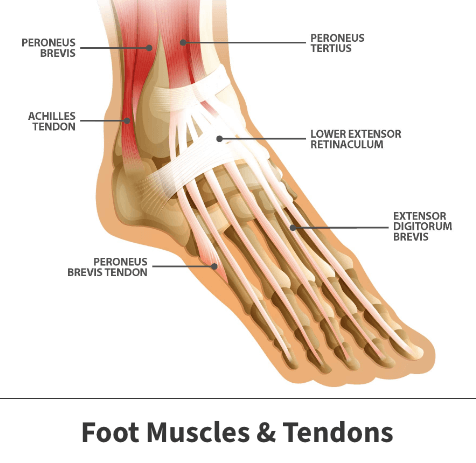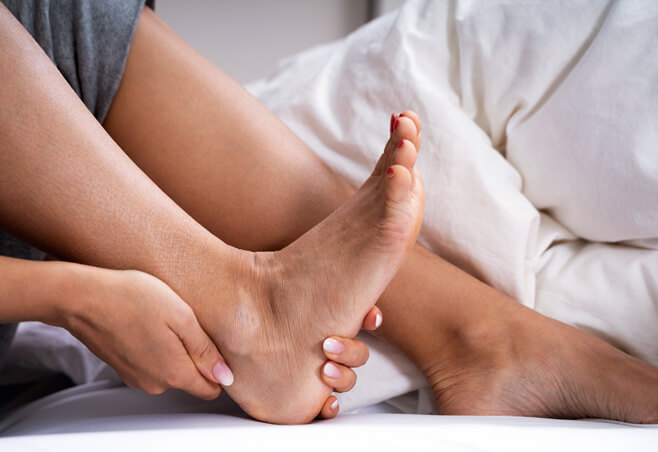Achilles tendonitis
The Achilles tendon, also known as the calcaneal tendon, is a tough, fibrous band of tissue that connects the calf muscle to the heel bone (calcaneus). Achilles tendonitis is a common condition that occurs when the large tendon that runs down the back of your lower leg becomes irritated and inflamed. The severity of the tendonitis is a major factor in the type of treatment you will receive. Regardless of the kind of treatment, most people make a full recovery in approximately 12 months.
Anatomy

The Achilles tendon, also known as the calcaneal tendon, is a tough, fibrous band of tissue that connects the calf muscle to the heel bone (calcaneus). When the calf muscles flex, the Achilles tendon pulls on the heel, allowing us to walk, run, climb stairs, jump, and stand on the tip of our toes. It is both the strongest and largest tendon in the entire body. While it may be the strongest, it is also vulnerable to injury, due to the high tensions placed on it and its limited blood supply. The tearing of the Achilles tendon is when the tendon tears, resulting in the separation of the tendon fibers. When this occurs, the tendon can no longer perform its normal functions.
About
Achilles tendonitis is a common condition that occurs when the large tendon that runs down the back of your lower leg becomes irritated and inflamed. Although the Achilles tendon can withstand high stresses from running and jumping, it is also prone to tendonitis, a condition associated with degeneration and overuse. There are two different types of Achilles tendonitis, noninsertional and insertional:
- Noninsertional Achilles Tendonitis. Fibers in the middle part of the tendon begin to break down with tiny tears, causing the tendon to swell and thicken. This type of tendonitis most commonly affects younger, active people.
- Insertional Achilles Tendonitis involves the lower part of the heel, where the tendon attaches to the heel bone. This type of tendonitis can occur at any time, even to people who are not active. Extra bone growth (bone spurs) often form with insertional Achilles tendonitis.
In both types, damaged tendon fibers may also harden (calcify).
Symptoms
Common symptoms of Achilles tendonitis include:
- Severe pain the day after exercising
- Thickening of the tendon
- Pain and stiffness along the Achilles tendon in the morning.
- Pain along the tendon or back of the heel that worsens with activity.
- Bone spurs (only with insertional tendonitis).
- Swelling that is present all the time, and gets worse throughout the day with activity.

Diagnosis
Your Florida Orthopaedic Institute physician will take a look at your symptoms, and examine your foot and ankle, keeping an eye out for:
- Swelling along the Achilles tendon or at the back of your heel.
- Bony spurs at the lower part of the tendon at the back of your heel (insertional tendonitis).
- Thickening or enlargement of the Achilles tendon.
- The point of greatest tenderness.
- Limited range of motion in your ankle—specifically, a decreased ability to flex your foot.
- Pain at the back of your heel at the lower part of the tendon (insertional tendonitis).
- Pain in the middle of the tendon (noninsertional tendonitis).
Your physician may also order some tests to make sure that your symptoms are caused by Achilles tendonitis and not something else. These tests include:
- X-rays – This test can show whether the lower part of the Achilles tendon has calcified, or become hardened. This calcification proves that you have insertional Achilles tendonitis.
- Magnetic Resonance Imaging (MRI) – This test is not actually necessary to diagnose Achilles tendonitis but it does help with planning surgery. An MRI scan can show the severity of the damage to the Achilles tendon. If surgery is needed, your doctor will select the procedure based on the amount of tendon damage.
Treatment
Nonsurgical treatments are in most cases, recommended first. If they are unsuccessful or if the tendonitis is severe, then surgical treatments are recommended. There are many different options for each type of treatment that will help you have a smooth recovery.
Nonsurgical treatment
Nonsurgical treatment, in most cases, will provide pain relief, though it may take a few months for symptoms to subside. The length of your recovery is heavily dependent on the severity of your injury. The following non-surgical treatments help expedite the healing process and ensure your safety:
- Rest – The first step to reducing pain is to allow yourself to rest by stopping all activities that make the pain worse. Switch to low-impact actives that put less stress on your Achilles tendon.
- Ice – Icing the area of pain can help with pain management and can be done throughout the day. This can be done for up to 20 minutes and should be stopped if the skin becomes numb
- Medication – Non-steroidal anti-inflammatory medication such as ibuprofen (Advil, Motrin) and naproxen (Aleve) help reduce swelling and pain.
- Exercise – Exercises that strengthen the calf muscles can reduce stress on the Achilles tendon.
Physical Therapy. - Cortisone injections – Cortisone is a type of steroid that works as a powerful anti-inflammatory used to help control the swelling caused by Achilles tendonitis.
- Extracorporeal shockwave therapy (ESWT) – High-energy shockwave impulses stimulate the healing process in damaged tendon tissue.
Surgical treatment
Surgery is only considered if the tendonitis does not improve after 6 months of non-surgical treatments. The specific type of surgery depends on the location of the tendonitis and the amount of damage to the tendon.
- Gastrocnemius recession – This is a surgical lengthening of the calf muscles (gastrocnemius muscles). Because tight calf muscles place increased stress on the Achilles tendon, this procedure is useful for patients who still have difficulty flexing their feet, even after consistently stretching the muscle. During this procedure, one of the two muscles that make up the calf is lengthened to increase the motion of the ankle.
- Debridement and repair – This procedure is only used when less than half of the tendon is damaged. The goal of this operation is to remove the damaged part of the Achilles tendon, and repair the remaining pieces of the tendon with sutures, or stitches. If you have insertional tendonitis, then bone spurs are also removed at the same time.
- Debridement with tendon transfer – This procedure is only used when more than half of the tendon is damaged. The tendon that helps the big toe point down is moved to the heel bone to add strength to the damaged tendon. Depending on the extent of damage to the tendon, some patients may not be able to return to competitive sports or running.
Recovery
Most patients have good results from surgery, and recovery usually lasts about 12 months. The greater the amount of tendon that is involved, the longer the recovery period, and the less likely a patient will be able to return to sports activity. Physical therapy will also be required to ensure a full recovery.
Videos
Related specialties
- Achilles Calcific Tendinitis
- Achilles Tendon Rupture
- Ankle Fracture Surgery
- Ankle Fractures (Broken Ankle)
- Ankle Fusion Surgery
- Arthroscopic Articular Cartilage Repair
- Arthroscopy of the Ankle
- Bunions
- Charcot Joint
- Common Foot Fractures in Athletes
- Foot Stress Fractures
- Hallux Rigidus Surgery - Cheilectomy
- Hammer Toe
- High Ankle Sprain (Syndesmosis Ligament Injury)
- Intraarticular Calcaneal Fracture
- Lisfranc Injuries
- Mallet, Hammer & Claw Toes
- Metatarsalgia
- Neuromas (Foot)
- Plantar Fasciitis
- Sprained Ankle
- Total Ankle Replacement
- Turf Toe
